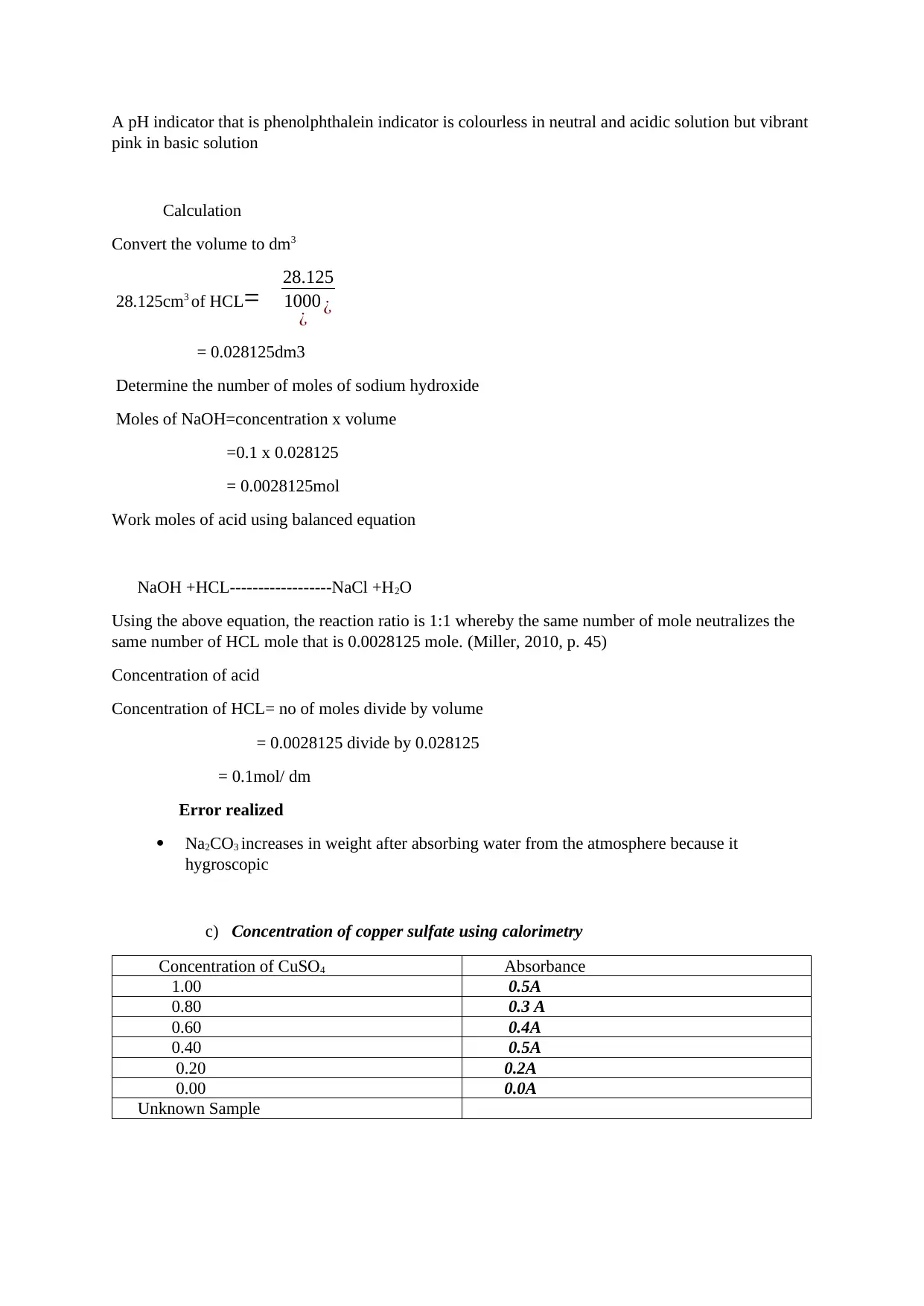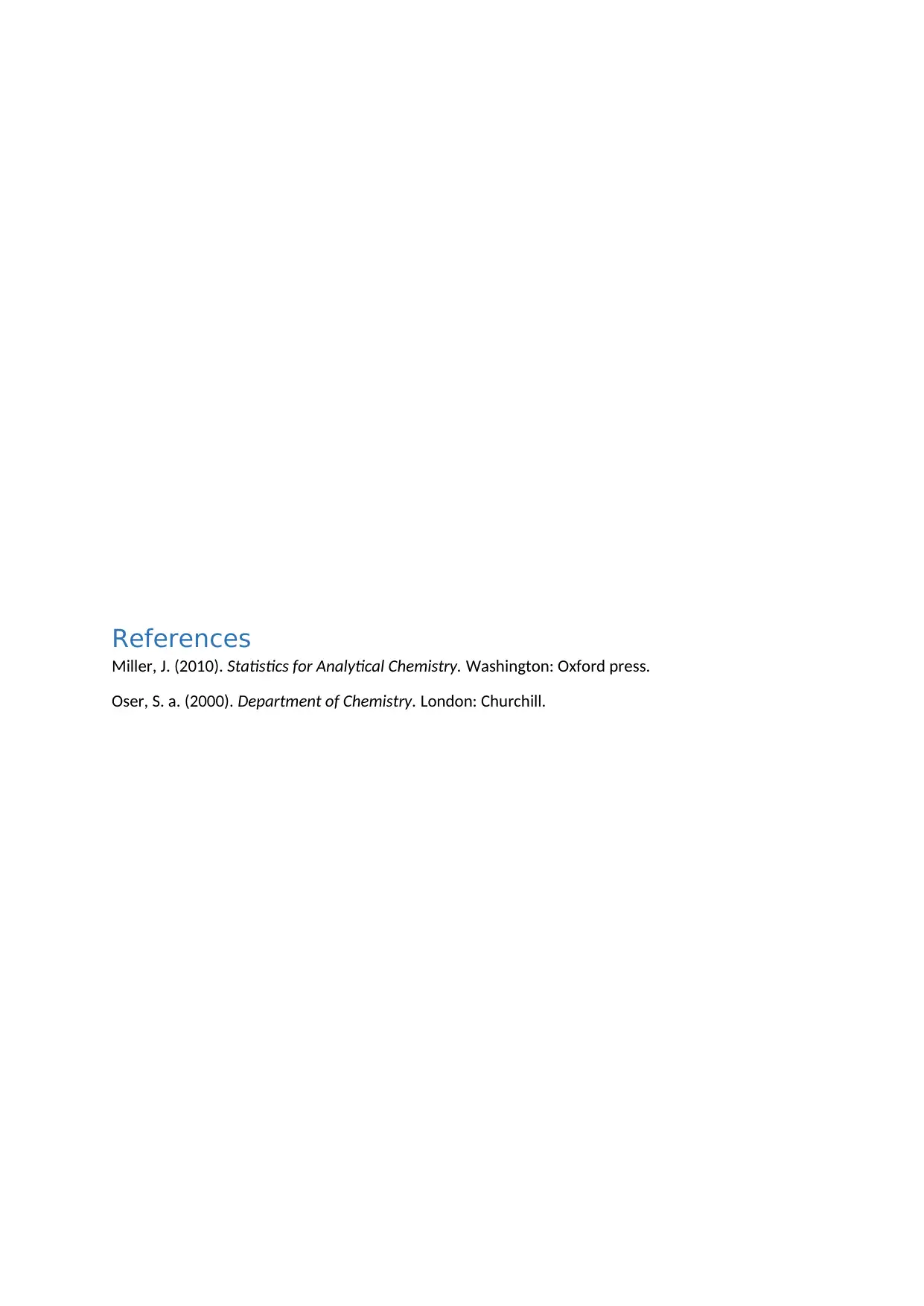Experiment on Determining Hydrochloric Acid (HCL) Concentration
VerifiedAdded on 2020/04/13
|6
|978
|596
Practical Assignment
AI Summary
This chemistry lab report details an experiment to determine the concentration of hydrochloric acid (HCL) using titration and calorimetry. The experiment involves standardizing HCL with sodium carbonate and sodium hydroxide, utilizing methyl and phenolphthalein indicators. Titration data, calculations, and analysis of results are provided, including the determination of copper sulfate concentration using calorimetry and Beer's law. The report addresses the accuracy of the experiment, potential errors, and risk assessments related to handling concentrated acids and bases. The student successfully determined the concentration of the solutions through the titration process and analysis of the endpoint. References include Miller (2010) and Oser (2000).

Name
City/ State
City/ State
Paraphrase This Document
Need a fresh take? Get an instant paraphrase of this document with our AI Paraphraser

This experiment was carried out in order to find the concentration of dilute hydrochloric acid by
titration. The process is known as standardizing the hydrochloric acid. This experiment aims at:
Using calorimetry to determine the concentration of copper sulfate.
Using NaHCO3 and NaOH to standardize HCL
Findings after titration
Run Initial Final Titre
Rough 0.00 24.40 24.4
1 0.00 23.85 28.85
2 23.85 47,65 23.85
3 0,00 23.80 23.80
Average 23.82
Titre 1 2 3 4 Average
Start volume
(ml)
5 17.5 4 4 7.625
End volume
(ml)
34.5 42.5 33.6 33.5 36,025
Volume used 29.5 25.0 29.6 28.4 28.125
a) Use of Sodium Carbonate to standardize HCL
The reaction between sodium carbonate and HCL takes place in two stages and methyl indicator and
phenolphthalein indicator were used in these experiments. The methyl indicator changes from yellow
to pink at the end of titration after which the volumes below were recorded. (Miller, 2010, p. 22)
Sodium Carbonate reacts with 1 mole of HCL to give NaHCO3
Na2CO3+ HCL---------------------NaHCO3 + NaCL
NaHCO3 + HCL------------------NaCl +H2O + CO2
Calculations
The mass of Na2Co3 for 250cm3 0.1M is calculated by;
Molarity= 0.1
Volume= 250cm3
Relative Atomic Mass= 106
Mass= 0.25 x 0.1x 106
Mass = 2.65g
Moles=mass divided by RAM
titration. The process is known as standardizing the hydrochloric acid. This experiment aims at:
Using calorimetry to determine the concentration of copper sulfate.
Using NaHCO3 and NaOH to standardize HCL
Findings after titration
Run Initial Final Titre
Rough 0.00 24.40 24.4
1 0.00 23.85 28.85
2 23.85 47,65 23.85
3 0,00 23.80 23.80
Average 23.82
Titre 1 2 3 4 Average
Start volume
(ml)
5 17.5 4 4 7.625
End volume
(ml)
34.5 42.5 33.6 33.5 36,025
Volume used 29.5 25.0 29.6 28.4 28.125
a) Use of Sodium Carbonate to standardize HCL
The reaction between sodium carbonate and HCL takes place in two stages and methyl indicator and
phenolphthalein indicator were used in these experiments. The methyl indicator changes from yellow
to pink at the end of titration after which the volumes below were recorded. (Miller, 2010, p. 22)
Sodium Carbonate reacts with 1 mole of HCL to give NaHCO3
Na2CO3+ HCL---------------------NaHCO3 + NaCL
NaHCO3 + HCL------------------NaCl +H2O + CO2
Calculations
The mass of Na2Co3 for 250cm3 0.1M is calculated by;
Molarity= 0.1
Volume= 250cm3
Relative Atomic Mass= 106
Mass= 0.25 x 0.1x 106
Mass = 2.65g
Moles=mass divided by RAM

= 2.65
106
¿ ¿
Moles= 0.025 moles
Concentration of Na2CO= mass divided by the volume obtained in the experiment
= 2.65
23.82
¿ ¿
= 0.11125
The equation below is used to calculate the HCL concentration,
Na2CO3 + 2HCL----------------------2NaCl + H2 O + CO2
1 mole 2moles 2 moles 1mole 1mol
Average titre from the table = 23.82cm3
Volume of Na2CO3 used= 25cm3
Molarity of Na2CO3= 0.1M
M1V1= M2V2
25cm3x 0.1 x 1= M2 x 23.82 x 2
M2= 25 cm x o .1
23.82
HCL concentration = 0.052476
Accuracy of the experiment
To ensure that the experiment is accurate;
The sodium used was in its purest state
The sodium carbonate was heated to get rid water of crystallization
The volumes used were accurately measured
b) Titration of Hydrochloric Acid with Sodium Hydroxide
106
¿ ¿
Moles= 0.025 moles
Concentration of Na2CO= mass divided by the volume obtained in the experiment
= 2.65
23.82
¿ ¿
= 0.11125
The equation below is used to calculate the HCL concentration,
Na2CO3 + 2HCL----------------------2NaCl + H2 O + CO2
1 mole 2moles 2 moles 1mole 1mol
Average titre from the table = 23.82cm3
Volume of Na2CO3 used= 25cm3
Molarity of Na2CO3= 0.1M
M1V1= M2V2
25cm3x 0.1 x 1= M2 x 23.82 x 2
M2= 25 cm x o .1
23.82
HCL concentration = 0.052476
Accuracy of the experiment
To ensure that the experiment is accurate;
The sodium used was in its purest state
The sodium carbonate was heated to get rid water of crystallization
The volumes used were accurately measured
b) Titration of Hydrochloric Acid with Sodium Hydroxide
⊘ This is a preview!⊘
Do you want full access?
Subscribe today to unlock all pages.

Trusted by 1+ million students worldwide

A pH indicator that is phenolphthalein indicator is colourless in neutral and acidic solution but vibrant
pink in basic solution
Calculation
Convert the volume to dm3
28.125cm3 of HCL= 28.125
1000
¿ ¿
= 0.028125dm3
Determine the number of moles of sodium hydroxide
Moles of NaOH=concentration x volume
=0.1 x 0.028125
= 0.0028125mol
Work moles of acid using balanced equation
NaOH +HCL------------------NaCl +H2O
Using the above equation, the reaction ratio is 1:1 whereby the same number of mole neutralizes the
same number of HCL mole that is 0.0028125 mole. (Miller, 2010, p. 45)
Concentration of acid
Concentration of HCL= no of moles divide by volume
= 0.0028125 divide by 0.028125
= 0.1mol/ dm
Error realized
Na2CO3 increases in weight after absorbing water from the atmosphere because it
hygroscopic
c) Concentration of copper sulfate using calorimetry
Concentration of CuSO4 Absorbance
1.00 0.5A
0.80 0.3 A
0.60 0.4A
0.40 0.5A
0.20 0.2A
0.00 0.0A
Unknown Sample
pink in basic solution
Calculation
Convert the volume to dm3
28.125cm3 of HCL= 28.125
1000
¿ ¿
= 0.028125dm3
Determine the number of moles of sodium hydroxide
Moles of NaOH=concentration x volume
=0.1 x 0.028125
= 0.0028125mol
Work moles of acid using balanced equation
NaOH +HCL------------------NaCl +H2O
Using the above equation, the reaction ratio is 1:1 whereby the same number of mole neutralizes the
same number of HCL mole that is 0.0028125 mole. (Miller, 2010, p. 45)
Concentration of acid
Concentration of HCL= no of moles divide by volume
= 0.0028125 divide by 0.028125
= 0.1mol/ dm
Error realized
Na2CO3 increases in weight after absorbing water from the atmosphere because it
hygroscopic
c) Concentration of copper sulfate using calorimetry
Concentration of CuSO4 Absorbance
1.00 0.5A
0.80 0.3 A
0.60 0.4A
0.40 0.5A
0.20 0.2A
0.00 0.0A
Unknown Sample
Paraphrase This Document
Need a fresh take? Get an instant paraphrase of this document with our AI Paraphraser

A direct relationship is formed by graphing the absorbance versus the concentration of the standard
solution. The direct relationship formed is known as Beer law and graph formed is a standard curve or
calibration curve. (Oser, 2000, p. 34)
C= A/ £l
C = 1. o 21
(2.81 Mcm)(1.0 cm)
Concentration=0.363M
Results analysis
In standardizing HCL using Sodium hydroxide, sodium hydroxide is neutralized using
hydrochloric acid to produce a solution containing sodium chloride which is a soluble salt. When
using methyl in the titration of strong acids and weak bases, it changes its colour from red to yellow
and this happens when its positive charge on hydrogen is neutralized by hydrogen.
In standardizing HCL using Sodium Carbonate, phenolphthalein indicator is used, the indicator
when dissolves in water form pink anions though, in the presence of acid, it remains colourless. An
increment in anions and pH above 8.2 makes the indicator to turn pink.
Absorption of more light in CuSO4 takes place at a higher wavelength than at lower
wavelength and molar absorptivity obtained from the CuSO4 standard solution helps to calculate the
unknown CuSO4 concentration
From the result, we are in a position of determining the concentration of the solution hence
concluding that the experiment was successful.
Risk assessment
Concentrated HCL must be used in fume cupboard which needs to be put in a place reachable to
the user. The user need also to know that acid, should be added to water and not vice versa. When
HCL is in use, the user needs to wear the lab coat, gloves, and safety glasses. In case of any spillage,
the user needs to clean the bench immediately. These risks are also associated with the NaOH and
they lead to personal injury, eye injury and chemical burns and harm in the cut.
Evaluation
Titration is the process whereby a concentration of known concentration is added to known
concentration until the unknown solution is neutralized and this helps to acquire information
concerning the unknown solution. Determination of the titration endpoint is carried out by the
indicator which is a weak acid. A point where the moles of hydroxide ions equals to the moles of
hydrogen ion is known as the equivalence point.
solution. The direct relationship formed is known as Beer law and graph formed is a standard curve or
calibration curve. (Oser, 2000, p. 34)
C= A/ £l
C = 1. o 21
(2.81 Mcm)(1.0 cm)
Concentration=0.363M
Results analysis
In standardizing HCL using Sodium hydroxide, sodium hydroxide is neutralized using
hydrochloric acid to produce a solution containing sodium chloride which is a soluble salt. When
using methyl in the titration of strong acids and weak bases, it changes its colour from red to yellow
and this happens when its positive charge on hydrogen is neutralized by hydrogen.
In standardizing HCL using Sodium Carbonate, phenolphthalein indicator is used, the indicator
when dissolves in water form pink anions though, in the presence of acid, it remains colourless. An
increment in anions and pH above 8.2 makes the indicator to turn pink.
Absorption of more light in CuSO4 takes place at a higher wavelength than at lower
wavelength and molar absorptivity obtained from the CuSO4 standard solution helps to calculate the
unknown CuSO4 concentration
From the result, we are in a position of determining the concentration of the solution hence
concluding that the experiment was successful.
Risk assessment
Concentrated HCL must be used in fume cupboard which needs to be put in a place reachable to
the user. The user need also to know that acid, should be added to water and not vice versa. When
HCL is in use, the user needs to wear the lab coat, gloves, and safety glasses. In case of any spillage,
the user needs to clean the bench immediately. These risks are also associated with the NaOH and
they lead to personal injury, eye injury and chemical burns and harm in the cut.
Evaluation
Titration is the process whereby a concentration of known concentration is added to known
concentration until the unknown solution is neutralized and this helps to acquire information
concerning the unknown solution. Determination of the titration endpoint is carried out by the
indicator which is a weak acid. A point where the moles of hydroxide ions equals to the moles of
hydrogen ion is known as the equivalence point.

References
Miller, J. (2010). Statistics for Analytical Chemistry. Washington: Oxford press.
Oser, S. a. (2000). Department of Chemistry. London: Churchill.
Miller, J. (2010). Statistics for Analytical Chemistry. Washington: Oxford press.
Oser, S. a. (2000). Department of Chemistry. London: Churchill.
⊘ This is a preview!⊘
Do you want full access?
Subscribe today to unlock all pages.

Trusted by 1+ million students worldwide
1 out of 6
Your All-in-One AI-Powered Toolkit for Academic Success.
+13062052269
info@desklib.com
Available 24*7 on WhatsApp / Email
![[object Object]](/_next/static/media/star-bottom.7253800d.svg)
Unlock your academic potential
Copyright © 2020–2025 A2Z Services. All Rights Reserved. Developed and managed by ZUCOL.